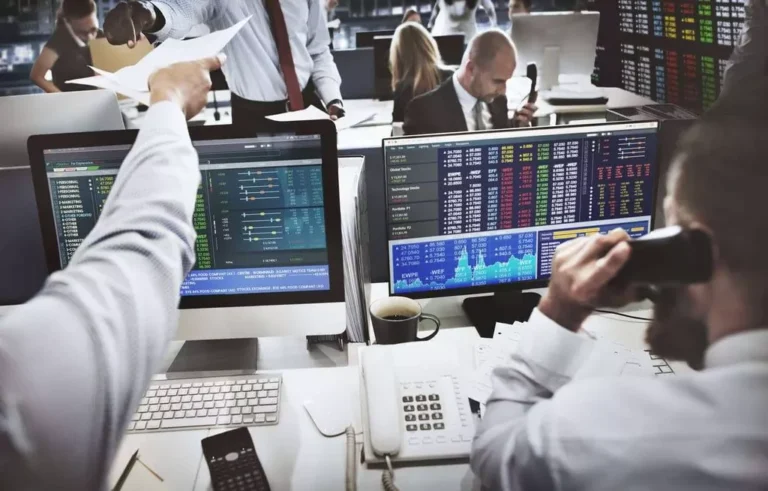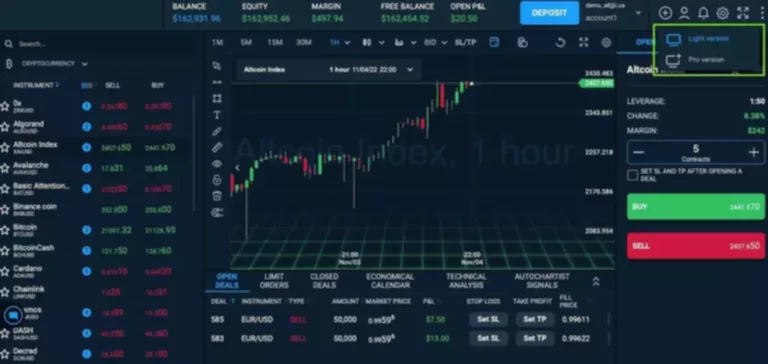What’s Automated Market Maker Amm? A Full Starter Guide Hela Blockchain
This is how an AMM transaction works and in addition the means in which an AMM acts as each liquidity provider and pricing system. Due to the flexibility of AMMs, a few of the hottest DEXs like Curve, Uniswap, and Bancor use an identical mechanism to operate. Conversely, centralized exchanges (CEXs) use an order e-book to match a purchaser with a vendor to execute a cryptocurrency trade at a mutually agreed change worth. Understanding AMMs is not just about grasping a model new financial software; it’s about recognizing a shift in how liquidity is supplied and how belongings are traded.
For occasion, yield farming and staking are ideas which have emerged from the symbiotic relationship between AMMs and different DeFi protocols, providing customers new ways to earn returns on their crypto property. The improve in recognition of DEXs and AMMs is disrupting the normal change listing process and order e-book mannequin. Furthermore, the rise in liquidity and total worth locked (TVL) in DEXs and AMMs means that non-custodial algorithmic protocols could quickly steal quite lots of market share from traditional exchanges.

Uniswap, Curve, and Balancer are distinguished first-generation automated market makers, but they aren’t with out their defects. The great thing about DeFi is that when conducting a token swap on a decentralized crypto trade (DEX), users never need a particular counterparty or middleman. Joining a liquidity pool is accessible to anybody with a self-custody pockets and compatible tokens. Participants are incentivized to contribute their tokens to those swimming pools by receiving a portion of the trading fees generated, proportional to their contribution. Secondly, Shared Pools enable anyone to provide liquidity and use the Balancer Pool Token (BPT) to track the ownership of the pool. However, Smart Pools can readjust the weighting and balances of belongings, in addition to trading charges.
Fixed Sum Market Maker (csmm)
AMMs are protocols that can allow buyers to purchase or promote crypto on decentralized exchanges with out counterparties for the trade. Therefore, automated market maker protocols might introduce massive ranges of flexibility within the domain of crypto trading. Interestingly, AMM-based exchanges current some notable differences from centralized exchanges.
- However, as with most progressive applied sciences, they come with their fair proportion of vulnerabilities.
- For instance, a hybrid mannequin can combine the CSMM variant’s ability to scale back the impression of enormous trades on the complete pool with the CMMM variant’s functionality to enable multi-asset liquidity pools.
- In probably the most fundamental sense, an AMM or automated market maker is basically a protocol, an algorithm, or a method that helps in the pricing of belongings.
- This mixed with its inside oracle and dynamic charges makes it one of the most advanced AMMs presently in use.
- Also aiming to increase liquidity on its protocol, DODO is using a mannequin known as a proactive market maker (PMM) that mimics the human market-making behaviors of a standard central restrict order guide.
Uniswap is a market maker large with over $3 billion whole value locked (TVL), dominating over 59% of total DEX quantity. Head of Strategy, Wee Kuo, a London School of Economics graduate, has excelled in roles at Genesis and at the Director and Head of Oil Trading in Asia. By simplifying the exchange process and making it more accessible, AMMs aren’t just a component of the DeFi ecosystem; they’re at its very core. They democratize finance, empower individuals, and pave the way for a more inclusive monetary system.
What Are Automated Market Makers (amms)?
Regardless, AMMs solve a key headache for crypto traders wishing to trade as and when they want, with out arbitrary boundaries or ‘terms and conditions’ laid down by third parties. An AMM can work in different ways, with different equations, and a few DEXes make use of hybrid models for handling token swaps. Constant Mean Automated Market Maker (CMMM) is a kind of AMM used to handle buying and selling between more than two property. This is called yield mining, the name stemming from the reality that extra tokens appear with increased liquidity pledges. In apply, many buyers search to maximize the potential yield by offering liquidity in all variety of locations to varied initiatives, and these entities are known as yield farmers. This mechanism thus determines asset pricing, according to the basic principle of provide and demand.

To utilize such a system, a centralized API have to be queried for a quote, which might then be used on-chain to execute the commerce. Off-chain pricing has the benefit of allowing for the utilization of off-chain information. This can embrace any of a range of private market-making ways, together with a marginal rate structure (used by Hashflow), or more traditional order e-book strategies used by centralized exchanges [16].
Underpinning AMMs are liquidity swimming pools, a crowdsourced collection of crypto assets that the AMM makes use of to trade with folks shopping for or promoting considered one of these belongings. The customers that deposit their belongings to the pools are known as liquidity providers (LPs). This occurs when the value of the belongings in a liquidity pool diverges in any path from the value at the time they were deposited. The term ‘impermanent’ means that the loss could presumably be momentary if the prices had been to revert to their unique state. However, if a liquidity supplier decides to withdraw their belongings from the pool whereas the costs are misaligned, the loss turns into everlasting. This risk is intrinsic to the AMM model and is extra pronounced in pools with highly unstable assets.
Learn all about Bitcoin halving occasions that greatly have an effect on the inflation fee and supply-to-demand ratio of BTC, and occur every four years till 2140. This allows AMMs to actively modify the worth of their market to be more according to the exterior market worth. Curve Finance executed a $2.5 million sUSD-USDC commerce that value lower than $2 in fuel charges.
Unlike their traditional exchange and market maker counterparts, an automated market maker operates on a wise contract that enables traders to provoke trades immediately and not using a counterparty. On the other hand, the impermanent loss doesn’t do appropriate justice for its name. Impermanence principally implies that when belongings revert to the prices at which they have been deposited originally, person losses are lowered. On the other hand, withdrawing your funds at a value ratio different from the one at which you deposited them may result in extra everlasting losses. While buying and selling charges might play a supporting role in mitigating the losses, the danger of impermanent loss would be important.
Through this feature, Balancer has a competitive advantage of higher fuel effectivity and deeper liquidity compared to a lot of its peers. However, the complexity of the platform might considerably hinder its progress potential and ease-of-use for newbies. The competitive benefit of Uniswap lies in its peerless excessive Automated Market Maker liquidity, monetary incentives in UNI rewards, and technological evolution. I am Joshua Soriano, a passionate writer and devoted layer 1 and crypto enthusiast. Armed with a profound grasp of cryptocurrencies, blockchain technology, and layer 1 options, I’ve carved a niche for myself in the crypto group.
Beyond providing steady liquidity and a permissionless setting, there are additional layers of benefits that AMMs present when compared to their traditional market counterparts. Built on Ethereum, the Uniswap decentralized trade (DEX) has catalyzed the AMM area attracting colossal amounts of liquidity. As the protocol uses open-source code, this makes copying and cloning comparatively easy.
Blockchain Gaming
Owing to variations in liquidity, volume, and even user behavior, there may be momentary value disparities between AMMs and conventional buying and selling platforms. These deviations from the honest market worth are nothing less than golden alternatives for eagle-eyed traders who’ve an urge for food for arbitrage. Beyond the conventional buying and selling charges, many AMMs provide extra incentives in the https://www.xcritical.in/ form of free tokens to LPs. The AMM, with its built-in algorithm, promptly presents the trade fee, drastically simplifying and expediting the trade on the decentralized change. Instead, they harness the ability of algorithmic equations to find out the worth and value of digital property dynamically. So, when a trader steps forth with an intention to purchase and promote orders or commerce assets, they’re now not mired within the seek for a matching counterparty.

Prior to the arrival of Automated Market Makers (AMMs), reaching liquidity was a big problem for decentralized exchanges (DEXs) on the Ethereum platform. Given the nascent nature of the know-how and its complicated interface, the pool of consumers and sellers was limited, making regular trading tough. AMMs have addressed this concern by establishing liquidity pools and incentivizing liquidity suppliers to supply these swimming pools with belongings. The larger the amount of property in a pool, the extra liquidity it possesses, thereby facilitating smoother trading on DEXs.
What’s Automated Market Maker?
The first-generation AMMs, notably popularized by platforms like Bancor, Curve, and Uniswap, fall into the class of Constant Function Market Makers (CFMMs). These function on the precept that the combined reserves of asset pairs in trading should remain constant. In these non-custodial AMMs, person deposits are aggregated within a sensible contract, providing liquidity for token swaps. Users trade in opposition to this good contract (the pooled assets), instead of directly with a counterparty, as seen in conventional order book exchanges. This model has proven extremely effective, but also generally requires liquidity suppliers to be extra active and informed in order to receive an excellent yield. The development of intelligent automated liquidity managing strategies will probably continue to make these (and similar) AMMs more effective, and the corresponding yield alternatives more competitive.
With their staggering total worth locked (TVL), these platforms epitomize the efficacy and dependability of the AMM framework. Let us assume a practical example for figuring out how liquidity is essential for Automated Market Makers. The greatest answer for you’ll be no, as you would never purchase all the Ether within the pool. You must pay exponentially larger and better premiums for every additional ETH you purchase from the ETH/DAI pool on Uniswap. Build your id as an authorized blockchain skilled with a hundred and one Blockchains’ Blockchain Certifications designed to offer enhanced career prospects.
Furthermore, Uniswap pools corresponding to ETH/DAI, that are extremely vulnerable to impermanent loss, have proven prospects of profitability with the accrued buying and selling charges. The method showcases the diploma of change in the ratio between tokens in a liquidity pool after a specific transaction. In the occasion of a massive margin of change within the ratio, you must worry about unreasonably high levels of slippage.
Arithmetic Underflow And Overflow Vulnerabilities In Smart Contracts
For this cause, Automatic Market Makers (AMM) have emerged as an efficient class of strategies to facilitate the trade of crypto assets on distributed ledgers. An AMM leverages good contracts to allow permissionless participation in market-making by individuals looking for yield. These individuals passively provide liquidity to the contract, which may then use a predetermined perform to routinely facilitate exchanges between patrons and sellers. The design of this process includes many tradeoffs that finally affect the utility of the platform to both liquidity suppliers and merchants. Automated Market Makers (AMMs) are a pivotal element of the Decentralized Finance (DeFi) ecosystem.
How Can The Current Amm Model Be Improved?
On the opposite hand, you can find a easy answer to “How do automated market makers work? A slippage risk in AMMs refers to the potential change within the worth of an asset between the time a commerce order is submitted and when it’s actually executed. Large trades relative to the pool size can have a big influence, causing the ultimate execution worth to deviate from the market worth from when the trade was initiated.
As an example, staking liquidity on a DEX might reward the liquidity provider with a token representing ownership of the small part of the liquidity pool they helped to create. This is worthwhile over time, as DEX charges deducted from trades — attainable because of AMMs — develop the liquidity pool and provide tangible positive aspects for liquidity suppliers. The transactions in automated market makers do not suggest the need for any counterparties as required in typical transactions. On the opposite hand, the transactions in AMMs are executed between users and sensible contracts. It is also attention-grabbing to note that you could not find any order varieties in an AMM crypto trade as a end result of lack of an order e-book.
